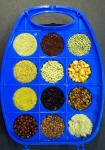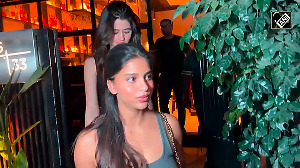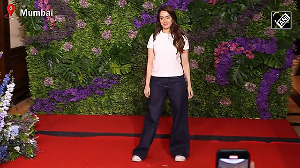As the driver looks on, the child glares and confronts him, "Aye, doon kya? (Hey, want me to give you ?)" The unnerved driver backs off and the boy settles his cycle. In the next scene, he tries his hand -- unsuccessfully -- at a funfair stall.
When the stall owner laughs, the boy poses the same, aggressive question and is quickly handed over a prize. Up next is a swimming competition, where the boy moves from second to first position after similarly scaring off the original winner.
The plot unravels when he yells "Doon kya?" at the conductor after almost missing the school bus. The angry adult asks the boy, "Kya dega re tu? (What will you give?)" Looking at him sheepishly, the boy pulls out a pack of Poppins from his pocket and asks, "Kya loge? Orange, pineapple ya strawberry?"
As the voiceover intones, "Parle Poppins mein itne saare flavours ki sabko dene ka man kare", the 30-second film ends with the boy winking into the camera saying, "Doon kya?"
It's been barely a year since its last advertising campaign for Poppins, but Parle feels the need to communicate with consumers again. That's probably because, even though Poppins is a popular heritage brand, the arrival of competition has left a sour taste in its mouth. Rivals Cadbury, Perfetti Van Melle, Nestlé and Godrej threaten Parle's 15 per cent share of the Rs 1,400-crore (Rs 14 billion) confectionery market (source: industry estimates).
"We were no longer the preferred choice among children from big cities. In the past few years we also began losing ground to brands like Mentos and Polo," confirms Pravin Kulkarni, general manager, marketing, Parle Products.
Previous campaigns for Poppins tried to address this issue by focusing on product attributes, like the variety of colours and flavours, and price.
Last year's ads emphasised the value-for-money proposition -- 10 candies for just Rs 2, compared to about 50 paise for each sweet otherwise. But children weren't buying that argument.
To ensure a more fruitful communication this time around, Parle decided to first study its consumer closely. The company surveyed 400 children in four major cities to understand their behaviour. It also roped in research agency IMRB to conduct a qualitative study of the market.
The research revealed that children above five years did not find the product appealing -- they considered Poppins too childish. Also, children in metros did not identify with the brand. The insight: Parle needed to target older children and portray a more relevant image for Poppins. "It is important to look at older children.
Not only do they have better spending power, but once they consume the brand, the product becomes aspirational for younger children," explains Kulkarni.
The brief to Everest Brand Solutions -- which has been Parle's creative partner for the past 52 years -- then, was simple. "Parle was clear that the brand needs to exemplify an attitude. Our aim was to make Poppins contemporary, stylish and a brand that urban 10-year-olds felt proud to carry," says N Padma Kumar, national creative director, Everest.
In all this, though, it was important to retain Poppins' original brand proposition -- this is a candy to be shared with others. After more than a month of brainstorming, Everest came up with a slightly different take on sharing -- the fiery youngster and his "doon kya?" approach. Parle liked the idea, not just because it showcased non-innocent behaviour that would appeal to a slightly older audience.
The company also believes "doon kya?" is a catchy phrase that may find a place in school children's lexicons, thereby improving brand salience. Incidentally, the tagline from a previous campaign -- Goli rainbow wali -- has been retained this time round, as well.
The 30-second film took just over two weeks to make: it was shot at various locations in Mumbai by film production company Future East. The ad is already on air on most children's entertainment channels, in time for the upcoming long summer break.
Television has a key role in the Poppins campaign. "Our target audience is children in the 5- to 14-year age group. Print or internet fails to reach a sizeable audience in this age group, which is why we are emphasising television," says Padma Kumar.
While most spends are reserved for channels like Pogo, Cartoon Network, Nick and Disney, Parle is also advertising on general entertainment and movie channels like Star Plus and Zee Cinema, to ensure better visibility. The full film will run for six weeks, after which a 20-second edit is planned.
Of course, the eye on television doesn't mean other media are excluded. Outdoor advertising in some cities is also planned. More importantly, Parle is focusing on point-of-sale material, like posters, danglers and dispensers.
Also on the cards is a packaging makeover. "We are looking at changing the packaging material and also introducing more colourful and interesting graphics. This will help further establish the rebranding exercise," agrees Kulkarni.
Parle will spend close to Rs 1 crore (Rs 10 million) on this campaign and hopes to boost sales of Poppins by 25 per cent. Whether children will warm up to the new, cool candy, remains to be seen.







 © 2025
© 2025